9 Species of Woodpeckers In Minnesota (With Pictures)
Last Updated on
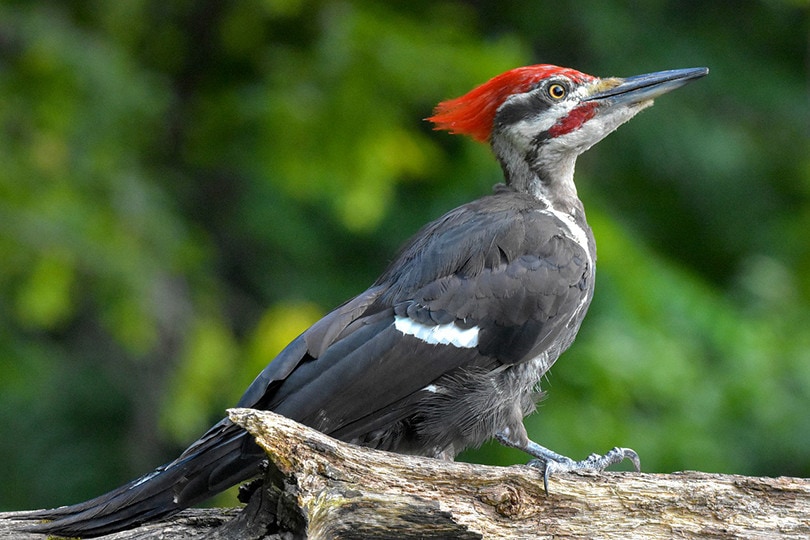
Minnesota provides habitats for nearly half of the 23 recognized woodpecker species. This includes nine resident and migrant varieties and two infrequently seen woodpecker species. The latter are birds that typically live in the Western United States but sometimes find themselves in the “Land of 10,000 Lakes.” Minnesota has just under 35% of forest acreage, which is the preferred habitat for woodpeckers.
Woodpeckers belong to the family Picidae. Their relatively large beaks and infamous drumming behaviors are their identifying traits. These birds vary in size from the petite Downy Woodpecker to the formidable Pileated Woodpecker. Most are year-round residents.

The 9 Species of Woodpecker in Minnesota
1. American Three-Toed Woodpecker (Picoides dorsalis)

| Size | 8–9.5 inches |
| Rarity | Uncommon |
| Habitat | Conifer forests and bogs |
The American Three-Toed Woodpecker is a species that forces birdwatchers to come to it instead of visiting a backyard bird feeder. Its preferred habitat makes this venture challenging because of its inhospitable environment. These woodpeckers are easier to spot during the winter than at other times of the year. Its distinguishing features are its barred back and flanks. Males also have a yellow cap.
American Three-Toed Woodpeckers have a close ecological relationship with the forest fire burn cycle. That puts them in direct conflict with humans encroaching on the conifer forests and halting these natural occurrences. While most species in this family are zygodactyl or four-toed, this bird’s name shows how it differs from the rest.
2. Black-Backed Three-Toed Woodpecker (Picoides arcticus)
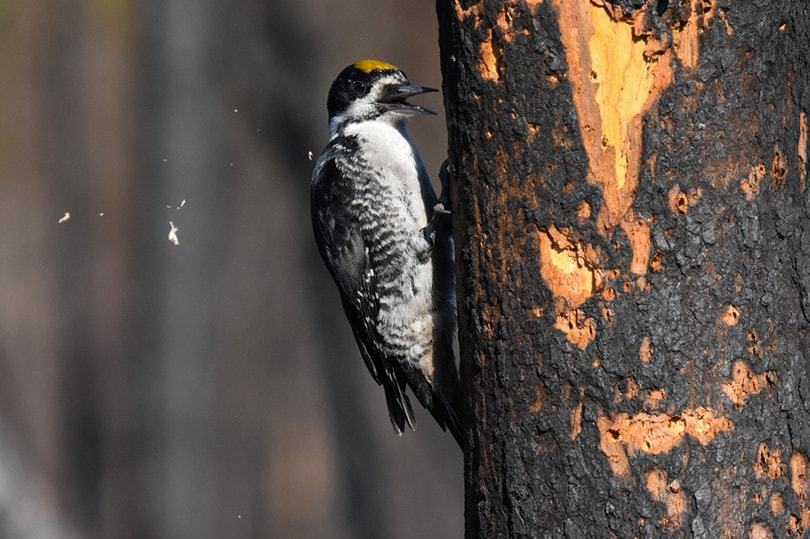
| Size | 9–10 inches |
| Rarity | Occasionally in the north |
| Habitat | Conifer forests and bogs |
The Black-Backed Three-Toed Woodpecker shares many of the same traits as the previous bird. It occupies similar habitats and depends on the fire ecology. This species has a more prominent beak and body with the same yellow cap. It’s also not as rare. Its numbers have increased in recent years, unlike the decline of the former. Scientists speculate that its superior camouflage may play a role in its survival.
The Black-Backed Three-Toed Woodpecker doesn’t migrate. However, it will move with changing habitat conditions. Living in recently burned forests provides abundant food for these birds. It also offers indirect protection from predators that typically won’t visit these otherwise desolate areas.
3. Downy Woodpecker (Picoides pubescens)

| Size | 6.5 inches |
| Rarity | Common year-round resident |
| Habitat | Forests, shade trees, parks |
The Downy Woodpecker is the species you’ll most likely see in your backyard, especially if you put out a suet feeder. It’s the country’s smallest representative of this bird family. These woodpeckers are year-round residents throughout Minnesota. The birds are monogamous and sexually dimorphic. The male has a bright red cap that distinguishes it from the female.
The female and male Downy Woodpecker will defend territory from others and won’t hesitate to chase an intruder. Like other woodpeckers, drumming is a form of communication used to mark its home ranges. These birds are omnivores that forage on various foodstuffs, including insects, seeds, and fruits.
4. Hairy Woodpecker (Picoides villosus)
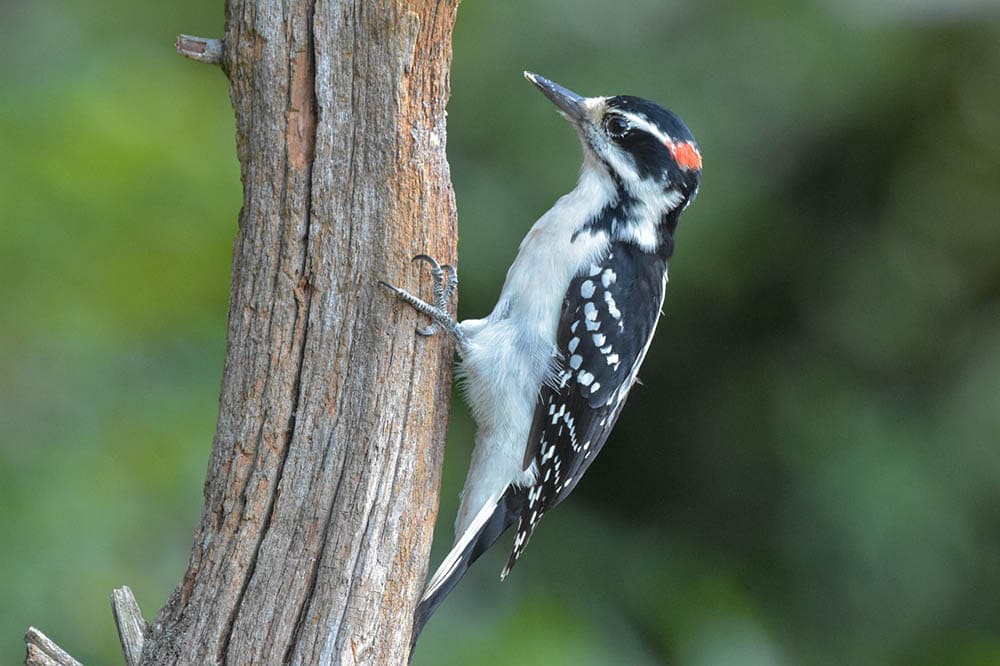
| Size | 9.5 inches |
| Rarity | Common year-round resident |
| Habitat | Forests and parks |
Some people confuse the Hairy Woodpecker with the Downy Woodpecker because of the similarities in their plumages. The male also has a red cap. However, you’re more likely to encounter this bird in forests instead of backyards. It has a larger beak and a higher-pitched voice similar to a rattle.
Despite habitat fragmentation, the Hairy Woodpecker population is thriving, with numbers increasing in recent years. It’s primarily an insectivore. However, it will occasionally feed on fruits, seeds, and sap. It is a year-round resident throughout Minnesota.
5. Northern Flicker (Colaptes auratus)

| Size | 12–14 inches |
| Rarity | Common year-round resident |
| Habitat | Forest edges, semi-open country |
The coloration of the Northern Flicker is unique, with mottling on its chest, a barred back, and its characteristic white rump. You can recognize this bird by its undulating flight with the occasional glimpse of its rump patch. This species differs from other woodpeckers in that it’s a ground feeder of ants. It has a long-barbed tongue to help catch the tiny insects.
The Northern Flicker is an interesting bird with a complete repertoire of displays and calls that make them fascinating to watch. Sadly, population numbers have decreased in recent years. Scientists suspect that ecological pressure from non-native species, such as the European Starling, may contribute to the decline. Flickers will move to more desirable habitats in the state during the winter.
6. Pileated Woodpecker (Dryocopus pileatus)

| Size | 16–19.5 inches |
| Rarity | Common |
| Habitat | Forest edges, semi-open country |
Seeing a Pileated Woodpecker is an experience you won’t forget. It isn’t just Minnesota’s largest representative—that title also applies to the entire North American continent. It has a large gray body with a white stripe down its neck and a red crest. Its size is enough to capture your attention, but it also has a booming voice that can send shivers down your spine. Its drumming is equally brash.
This woodpecker feeds primarily on insects but will also branch out to nuts and fruits. If you don’t see the bird, you’ll know one is in residence by the oblong excavations on tree trunks with piles of sawdust underneath it. Unfortunately, that behavior sometimes puts it in conflict with humans because of its destruction.
7. Red-Bellied Woodpecker (Melanerpes carolinus)
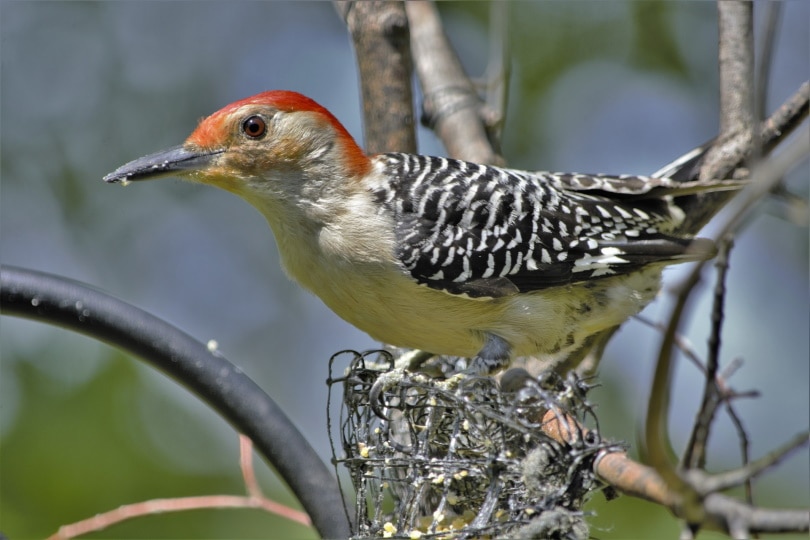
| Size | 9–10.5 inches |
| Rarity | Common in the state’s southern half |
| Habitat | Forests, shade trees |
You’d think that the name for the Red-Bellied Woodpecker is a misnomer. Instead of on the male’s belly, the cap and back of its head are where you’ll see red. The female lacks the coloration on top. Its behavior and voice resemble the Northern Flicker. Unlike the flicker species, its population has increased despite pressure from invasive birds.
The Red-Bellied Woodpecker prefers the warmer weather of southern Minnesota, where they are year-round residents. Like the Northern Flicker, this bird is always on the move, hopping on the ground or up tree trunks. It is an omnivore that will readily visit your bird feeders as well.
8. Red-Headed Woodpecker (Melanerpes erythrocephalus)
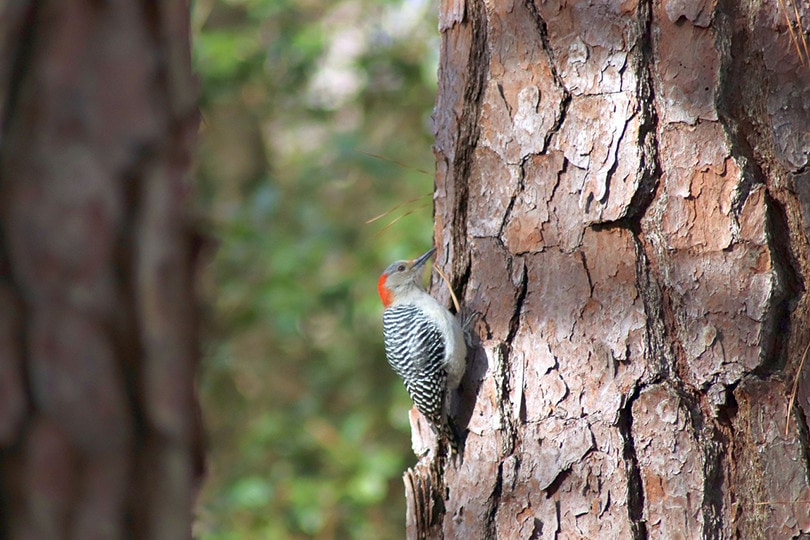
| Size | 8.5–9.5 inches |
| Rarity | Common |
| Habitat | Small yards and patios |
The Red-Headed Woodpecker is a striking bird with its white and black plumage and bright red head. Unlike many species in this family, males and females look alike. Birds in southern Minnesota are typically year-round residents, whereas others in the colder northern reaches will head toward better habitats in the winter. They are omnivores that will eat anything from frogs to nuts.
While the International Union for Conservation of Nature and Natural Resources (IUCN) lists it as a species of least concern, its numbers have declined rapidly over the past few decades. These birds prefer dead trees, which puts them in conflict with humans. Habitat encroachment and loss are their main threats. Scientists also suspect predation by feral and outdoor cats is another factor responsible for the declining numbers.
9. Yellow-Bellied Sapsucker (Sphyrapicus varius)

| Size | 8–9 inches |
| Rarity | Common |
| Habitat | Forested areas |
The Yellow-Bellied Sapsucker is the only species on our list that is a true migrant. These birds always leave for warmer weather in Mexico and Central America. The Yellow-Bellied Sapsucker name you a lot about their behavior. This bird will drill holes into trees and lap up the sap with its long tongue. It also feeds on insects, fruits, and berries, meaning that a harsh Minnesota winter won’t supply these foods.
The number of the Yellow-Bellied Sapsuckers has been declining. Nevertheless, the IUCN considers it a species of least concern. During the breeding season, it’ll travel as far north as Canada, but year-round populations also exist in Central America. It even makes it across the pond to Great Britain occasionally.
Related Read: 8 Species of Woodpeckers in Florida (with Pictures)
Tips for Living With Woodpeckers
Woodpeckers are usually birds we welcome at our bird feeders. However, some occasionally become a nuisance when they take to our houses with their drumming to find food—especially if you have wooden siding or shingles. The solution to this problem is to make your home as inhospitable as possible to persuade them to move elsewhere.
Many homeowners have been successful with scare tactics, such as metallic tape. The flashing reflections are often enough to keep these birds at bay. It’s most effective if you use long strips. Don’t forget to replace any damaged pieces. Some people have used old CDs or pie tins if the woodpeckers target inconspicuous spots on their houses.
A fake owl is another solution that many homeowners swear by. You have the best luck with a fabric owl that moves instead of a plastic one. Another option is to hang a silhouette of a hawk. Many bird species recognize this shape and their instincts tell them to avoid it.
In Conclusion
Woodpeckers never cease to fascinate us. They are resourceful at finding food where other species might not even look. Woodpeckers also use their drumming behavior for marking territories, finding mates, and protecting their young. Many birds are also adaptable, moving from the frigid northern reaches of Minnesota to warmer southern forests.
Woodpeckers have excellent places to take up residence with the abundance of forests in the state. As long as they bypass our houses, they are welcome visitors that provide free pest control.
Featured Image Credit: JackBulmer, Pixabay
Table of Contents
- The 9 Species of Woodpecker in Minnesota
- 1. American Three-Toed Woodpecker (Picoides dorsalis)
- 2. Black-Backed Three-Toed Woodpecker (Picoides arcticus)
- 3. Downy Woodpecker (Picoides pubescens)
- 4. Hairy Woodpecker (Picoides villosus)
- 5. Northern Flicker (Colaptes auratus)
- 6. Pileated Woodpecker (Dryocopus pileatus)
- 7. Red-Bellied Woodpecker (Melanerpes carolinus)
- 8. Red-Headed Woodpecker (Melanerpes erythrocephalus)
- 9. Yellow-Bellied Sapsucker (Sphyrapicus varius)
- Tips for Living With Woodpeckers
- In Conclusion
About the Author Chris Dinesen Rogers
Chris has been writing since 2009 on a variety of topics. Her motto with all of her writing is “science-based writing nurtured by education and critical thinking.” Chris specializes in science topics and has a special love for health and environmental topics, and animals of all shapes and sizes.
Related Articles:
How to Collimate Binoculars: 9 Expert Tips
Monocular vs Telescope: Differences Explained (With Pictures)
10 Types of Hummingbirds in Arkansas (With Pictures)
8 Types of Hummingbirds in Nebraska (With Pictures)
5 Types of Hummingbirds in Idaho (With Pictures)
3 Types of Hummingbirds in Mississippi (With Pictures)
8 Types of Hummingbirds in Kansas (With Pictures)
5 Types of Hummingbirds in West Virginia (With Pictures)
